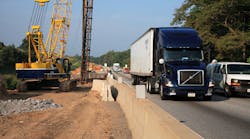More roadways tolls and other fees are in the works for 2014, according to a forecast report by Fitch Ratings, as state governments try to find ways to fund transportation infrastructure needs as the flow of federal money continues to shrink.
“We’re already seeing states raising fees of all kinds on transportation users and we expect to see more of that over the next year,” Eric Kim, Fitch’s director of public finance, told Fleet Owner during a media conference call to review the firm’s 2014 Outlook: U.S. Transportation Infrastructure report. “We don’t have specific prospects for what kinds of fees exactly, but state governments are certainly moving in that direction.”
Such “moves” are occurring as federal fuel tax revenues earmarked to fund transportation needs continue to fall – a trend stressed at the Infrastructure of the Future summit held in Washington D.C. last month – and states try to fill the resulting “funding gap” with other methods.
One such method Fitch expects to see deployed more frequently in the coming year is public-private partnerships or “P3” deals where by private firms invest in transportation projects alongside state and local governments, using tolls to collect a return.
“The growing use of P3 transactions to construct new or expand existing projects is largely motivated by limited resources at the state and local level, combined with uncertainty on future federal funding levels,” noted said Scott Zuchorski, director in the Fitch’s global infrastructure group, in a statement.
“While not a panacea for all funding issues, governments are increasingly looking to P3s for transportation projects where the economics make sense,” he said. “Two-thirds of states currently have P3 enabling legislation in place, and given the size of future capital needs, Fitch expects transportation P3s to continue to rise in 2014.”
Emma Griffith, one of Fitch’s directors, added during the media call that the firm believes not only will tolling become more widespread in 2014, especially for the construction of new roadway capacity, there will be “increasing” pressure to place tolls on what were beforehand “free” roads as well.
“Uncertainty at the federal level is contributing to this trend,” she said, noting that the current soon-to-expire highway bill – MAP-21, short for the “Moving Ahead for Progress in the 21st Century” Act – incorporated two transfers of monies from the federal government’s general revenue fund to the shrinking Highway Trust Fund (HTF) to offset declines in fuel tax revenue.
“Federal funding to state DOTs is down 22%, including a 7% cut due to sequestration, which is leading states to implement new [fuel] taxes, fees, and P3s to maintain and expand roadways,” Griffith pointed out. “It’s all related to that growing lack of federal funding.”
In terms of specific transportation infrastructure sectors, Fitch’s outlook for the U.S. toll roads segment is stable, reflecting continued slow growth in aggregate driving across the country. Even in a declining traffic scenario, mature assets and systems with a combination of pricing power, robust liquidity and moderate leverage retain considerable resilience to sustain current rating levels, the firm noted.
However, the forecasting risk for the toll road segment remains high for recently constructed or green field stand-alone projects, which may be more vulnerable to a sustained weak economic environment, the firm stressed.
The outlook for U.S. ports remains stable for 2014 as well, said Fitch, with flat to modest improvements in port throughput and largely stable revenue profiles expected.
Macroeconomic trends both in the U.S. and globally will affect throughputs and shifts in trade volumes, though contracts at the largest ports should insulate cash flows from volume volatility, the firm reported.
Effects of shipping alliances on service frequency and cargo volumes continue to be monitored, as do expansionary capital expansion programs at several ports, with Fitch expecting ongoing negative pressure on throughput as U.S. consumers continue to exercise caution.
The forecast for both roads and ports fall in line with analysis Fitch conducted for its last transportation infrastructure report back in October.
The firm noted that traffic and vehicle miles traveled (VMT) declines were offset by above-inflationary toll increases, resulting in revenue growth of 4.6% through June of this year However, the differential between revenue and traffic/VMT growth rates is narrowing, indicating road operators' weakening pricing power.
Expressways saw continued traffic growth, while turnpike, bridge and stand-alone categories all experienced declines, said Fitch, with the Southwest, West and Midwest regions experienced traffic growth, while Southeast traffic was flat.
U.S. ports are also showing mixed results for the first half of 2013, with 50% of ports displaying year-over-year declines while the other 50% reported modest volume gains. Figures for the first six months through June of this year indicate a year-over-year decline of approximately 1.2%, Fitch noted, weaker than the 0.6% overall growth for calendar year 2012.



